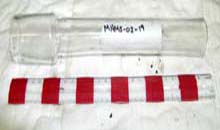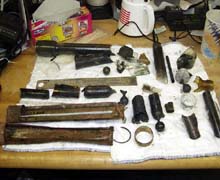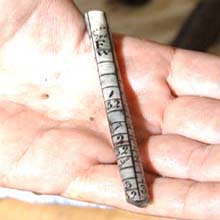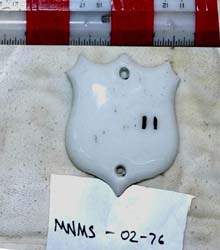Some of the artifacts recovered during the excavation on July 13, 2002. Items include two thermometers, fragments of lantern chimneys, broken bottles and broken hydrometers. Click image for larger view and detailed explanation.

An intact glass lantern chimney. This chimney was recovered from underneath large fragments of iron and coal.Click image for larger view and detailed explanation.
Artifacts Galore
July 13, 2002
Jeff Johnston
Monitor National Marine Sanctuary
![]() Watch a video of an underwater scene (mp4 338 KB).
Watch a video of an underwater scene (mp4 338 KB).
Although the decking and armor belt have been removed from over the turret, the area around it is still deep with sediment, coal and debris. To properly position the spider and the claw for recovery, we must clear a circumferential zone of about six feet out around the turret. Thus, surface-supplied divers continue the work of clearing around the outside the Monitor’s gun turret.
Divers on the night shift had been working to clear a large fragment of deck plate from the inboard side of the turret. At about 3 am, one of the divers noticed glass fragments in the area and called it to our attention.
I sent her over to investigate the area. Just under the sediment, she found additional glass fragments and two glass lantern chimneys. Because the divers had no suitable tools on the bottom at the time to use for recovering the artifacts, the chimneys and glass fragments were placed in a bucket to be brought to the surface later. This area had to be cleared for the turret recovery, so we decided to check for additional artifacts on subsequent dives.
The next set of surface divers recovered numerous fragments of lantern chimneys and glass bottles. Additionally, there were several broken hydrometer parts, another intact glass lantern chimney, one intact thermometer and the fragments of another.
As the divers were searching the area for additional artifacts, I spotted segments of wood lying in the silt that were obviously not portions of decking. It appeared that we had dug into the remnants of what was at one time a storage cabinet that was located at the extreme end of the lower hull aft of the Monitor’s engine. Divers removed the artifacts in the path of the clearing work. We decided to wait for daylight to continue the investigation. When the sun came up, which afforded us a little daylight on the bottom, we sent the saturation (SAT) diver over to survey the area.
The large concretion mass over and inboard of the glass that was recovered earlier contained several large brass bearing halves for the main engine, numerous firebricks, what appears to be at least a shot of chain, and the ever-present chunks of coal. The SAT diver continued to search around the base of the concretion pile. He managed to recovered several additional fragments of the glass hydrometers, bottle fragments, two porcelain cabinet knobs, and two more thermometers. As he continued to dig, he uncovered a void area that confirmed our suspicions—this was indeed, at one time, a storage cabinet. Likely, the cabinet had contained spare engine room instruments, spare chimneys for the engine room lanterns, and bottles.
After the shift change at noon, we again sent the SAT diver on duty over to the cabinet area to make sure that there were no more artifacts left in the path of the clearing around the turret. The diver found some additional hydrometer fragments and a large white ceramic shield. The shield displayed traces of black markings and two holes for securing it in place.
Based on accounts of later class monitor-type vessels, we assumed that cabinet doors, storage lockers, and the like in the Monitor were labeled with “white tags,” which surely would have made identification easier in the low-light environment. Once we had the shield up on deck, however, the shield teased us like so many other artifacts recovered from the site. Whatever name it once bore had been simply painted on the shield's surface, and most of the paint was gone. Viewed at an angle, it appears to have been three letters, but we cannot determine with certainty what it says. Hopefully, conservation efforts will solve this mystery for us.
When the Monitor sank on that stormy New Year’s Eve, whatever was not secured in the aft area of the ship tumbled to the aft-most sections of the hull. Unfortunately, the falling bearings, firebricks, and chain destroyed this cabinet that had contained these delicate spare instruments.
In a couple of weeks, the NOAA team will arrive onsite. With their help, we will further excavate this area of the wreck.
Sign up for the Ocean Explorer E-mail Update List.




































